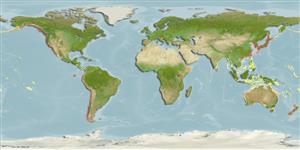Phascolosoma agassizii Keferstein, 1866
Agassiz'z peanut worm| Native range | All suitable habitat | Point map | Year 2050 |

|
| This map was computer-generated and has not yet been reviewed. |
| Phascolosoma agassizii AquaMaps Data sources: GBIF OBIS |
Upload your photos
Google image |
No photo available for this species.No drawings available for Phascolosomatidae.
Google image |
No photo available for this species.
Classification / Names Common names | Synonyms | CoL | ITIS | WoRMS
Phascolosomatidea | Phascolosomatida | Phascolosomatidae
Environment: milieu / climate zone / depth range / distribution range Ecology
Benthic; depth range 0 - 5 m (Ref. 1815). Temperate
Distribution Countries | FAO areas | Ecosystems | Occurrences | Introductions
Indo-Pacific and the Mediterranean: Korean Peninsula.
Length at first maturity / Size / Weight / Age
Maturity: Lm ? range ? - ? cm Max length : 4.0 cm TRKL male/unsexed; (Ref. 1815)
Short description Morphology
Comparatively large animals of grayish yellow color. Body cylindrical. Trunk region 0.4 - 4 cm
long. Introvert almost as long as trunk region. Entire body surface densely set with large (0.06 - 0.08 cm) dome-shaped black papillae. Papillae especially numerous on terminal and anal shields. Cephalon bear-ing crown of 21-29 tentacles in horseshoe-like arrangement
around heart-shaped nuchal organ. Behind cephalon, introvert bearing specialized cuticular appendages (scalids), arranged into 15-30 circles. Two ventral and two dorsal retractors of introvert. Ventral retractors anchored in posterior third of trunk. Contractile vessel simple, with no lateral branches. Intestine with 10-18 loops, in dependence on animal size. Longitudinal
musculature of body wall divided into pronounced, isolated longitudinal bands. Spindle-shaped muscle fastened at terminal end of trunk; 1-3 fixing muscles. Anus located somewhat in front of or level with nephrophores. Wing muscles well-developed. Rectal diverticulum
absent. 2 nephridia fastened to body wall along 1/3 of their length via thin mesenterial filaments. Nephridiums 30 - 50 percentage as long as trunk (Ref. 1815).
Intertidal and subtidal on vegetation (Ref. 1815). Depth based on occurrence (Ref. 1815); to be replaced with better reference. Subtidal (Ref. 1815).
Life cycle and mating behavior Maturity | Reproduction | Spawning | Eggs | Fecundity | Larvae
Main reference
References | Coordinator | Collaborators
Morozov, T.B. and A.V. Adrianov. 2002. (Ref. 1815)
IUCN Red List Status (Ref. 130435)
CITES status (Ref. 108899)
Not Evaluated
CMS (Ref. 116361)
Not Evaluated
Threat to humans
Human uses
| FishSource |
Tools
More information
Internet sources
BHL | BOLD Systems | CISTI | DiscoverLife | FAO(Publication : search) | Fishipedia | GenBank (genome, nucleotide) | GloBI | Gomexsi | Google Books | Google Scholar | Google | PubMed | Tree of Life | Wikipedia (Go, Search) | Zoological Record
Estimates based on models
Preferred temperature
(Ref. 115969): 7.7 - 28.8, mean 21.6 (based on 2164 cells).
Price category
(Ref. 80766):
Unknown.


